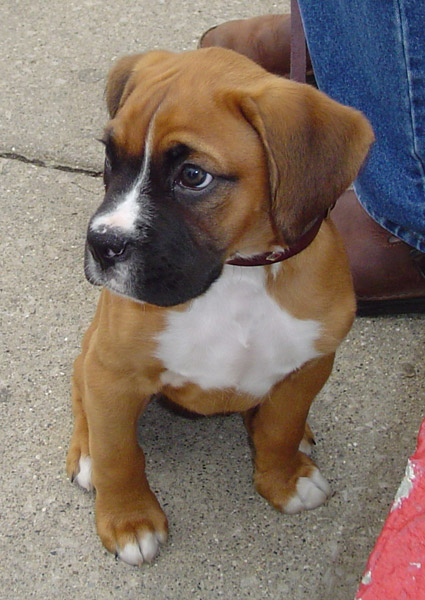The Boxer is a breed of stocky, medium-sized, short-haired dog with a smooth fawn or brindled coat and square-jawed muzzle. Boxers are brachycephalic, and have an underbite, very strong jaws and a powerful bite. They are part of the molosser group of dogs, bred from the extinct German bullenbeisser and the bulldog.
 They are a bright, energetic and playful breed and tend to be very good with children. It's best if obedience training is started early since they also have a strong personality and therefore can be harder to train when older. This, in addition to their strength, might present a challenge for a first-time dog owner. Boxers have earned a slight reputation of being "headstrong", which can be related to inappropriate obedience training. Owing to their intelligence and working breed characteristics, training based on the use of corrections often has limited usefulness. Boxers often respond much better to positive reinforcement techniques such as clicker training. It is also true that Boxers have a very long puppyhood and adolescence, and are often called the "Peter Pan" of the dog world. They are not considered fully mature until two to three years of age, one of the longest times in dogdom, and thus need early training to keep their high energy from wearing out their owner. They are a bright, energetic and playful breed and tend to be very good with children. It's best if obedience training is started early since they also have a strong personality and therefore can be harder to train when older. This, in addition to their strength, might present a challenge for a first-time dog owner. Boxers have earned a slight reputation of being "headstrong", which can be related to inappropriate obedience training. Owing to their intelligence and working breed characteristics, training based on the use of corrections often has limited usefulness. Boxers often respond much better to positive reinforcement techniques such as clicker training. It is also true that Boxers have a very long puppyhood and adolescence, and are often called the "Peter Pan" of the dog world. They are not considered fully mature until two to three years of age, one of the longest times in dogdom, and thus need early training to keep their high energy from wearing out their owner.
The boxer by nature is not an aggressive or vicious breed, but needs socialization to tolerate other dogs well. Their sometimes over-protective, territorial and dominating attitude, often most intense in males, can be problematic. . Boxers are generally patient with smaller dogs but can be dominant with larger dogs of the same sex.
Boxers are friendly, lively companions that are popular as family dogs. Their suspicion of strangers, alertness, agility, and strength make them formidable guard dogs. They sometimes appear at dog agility or obedience trials and flyball events. These strong and intelligent animals have also been used as service dogs, guide dogs for the blind, therapy dogs, police dogs, and occasionally herding cattle or sheep.
The history of the boxer
The ancestors of this breed were the German bullenbeisser (bull biter), a dog of Mastiff descent, and the bulldog. The bullenbeisser had been working as a hunting dog for centuries, employed in the pursuit of bear, wild boar, and deer. Its task was to seize the prey and hold it until the hunters arrived. In later years, faster dogs were favoured and the bullenbeisser grew smaller and was then called the brabanter.
In the late 19th century, the brabanter was crossed with a bulldog to start the line that would become the modern boxer. In 1894, three Germans by the name of Roberth, Konig, and Hopner decided to stabilize the breed and put it on exhibition at a dog show. This was done in Munich in 1895, and the next year they founded the first Boxer Club.
The breed was introduced to other parts of Europe in the late 1890s and to the United States around the turn of the century.
During World War I, the boxer was used for military work, acting as a valuable messenger dog, pack-carrier, attack dog, and guard dog.
It was not until after World War II that the boxer became popular around the world. Boxer mascots, taken home by returning soldiers, introduced the dog to a much wider audience and it soon became a favorite as a companion animal, as a show dog, and as a guard dog.
Health
Boxers are prone to develop cancers, heart conditions such as aortic stenosis and arrhythmogenic right ventricular cardiomyopathy (the so-called "Boxer Cardiomyopathy"), hypothyroidism, hip dysplasia, and degenerative myelopathy; other conditions that may be seen are gastric dilatation and torsion (bloat), intestinal problems, and allergies (although these may be more related to diet than breed). Entropion is occasionally seen, a malformation of the eyelid requiring surgical correction. Responsible breeders test their breeding stock before breeding and in some cases throughout the life of the dog in an attempt to minimize the occurrence of these diseases in future generations. Healthy boxers enjoy an average lifespan of 10-12 years.
Boxers are an athletic breed, and proper exercise and conditioning is important for their continued health and longevity. Care must be taken not to over-exercise young dogs, as this may damage growing bones; however once mature boxers can be excellent jogging or running companions. Because of their brachycephalic head, they do not do well in high heat or humidity, and common sense should prevail when exercising a boxer in these conditions. |
|

